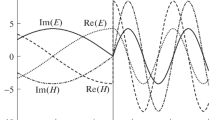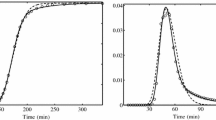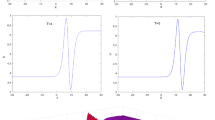Abstract
A new semi-analytical solution to the advection–dispersion–reaction equation for modelling solute transport in layered porous media is derived using the Laplace transform. Our solution approach involves introducing unknown functions representing the dispersive flux at the interfaces between adjacent layers, allowing the multilayer problem to be solved separately on each layer in the Laplace domain before being numerically inverted back to the time domain. The derived solution is applicable to the most general form of linear advection–dispersion–reaction equation, a finite medium comprising an arbitrary number of layers, continuity of concentration and dispersive flux at the interfaces between adjacent layers and transient boundary conditions of arbitrary type at the inlet and outlet. The derived semi-analytical solution extends and addresses deficiencies of existing analytical solutions in a layered medium, which consider analogous processes such as diffusion or reaction–diffusion only and/or require the solution of complicated nonlinear transcendental equations to evaluate the solution expressions. Code implementing our semi-analytical solution is supplied and applied to a selection of test cases, with the reported results in excellent agreement with a standard numerical solution and other analytical results available in the literature.



Similar content being viewed by others
References
Carr, E.J.: Generalized semi-analytical solution for coupled multispecies advection–dispersion equations in multilayer porous media (2020). arXiv:2006.15793
Carr, E.J., March, N.G.: Semi-analytical solution of multilayer diffusion problems with time-varying boundary conditions and general interface conditions. Appl. Math. Comput. 333, 286–303 (2018)
Carr, E.J., Pontrelli, G.: Modelling mass diffusion for a multi-layer sphere immersed in a semi-infinite medium: application to drug delivery. Math. Biosci. 303, 1–9 (2018)
Carr, E.J., Turner, I.W.: A semi-analytical solution for multilayer diffusion in a composite medium consisting of a large number of layers. Appl. Math. Model. 40, 7034–7050 (2016)
Chen, J.S., Hsu, S.Y., Li, M.H., Liu, C.W.: Assessing the performance of a permeable reactive barrier–aquifer system using a dual-domain solute transport model. J. Hydrol. 543, 849–860 (2016)
Chen, H., Park, E., Hu, C.: A design solution of PRB with multispecies transport based on a multidomain system. Environ. Earth Sci. 77, 630 (2018)
Chen, J.S., Ho, Y.C., Liang, C.P., Wang, S.W., Liu, C.W.: Semi-analytical model for coupled multispecies advective–dispersive transport subject to rate-limited sorption. J. Hydrol. 579, 124164 (2019a)
Chen, J.S., Liang, C.P., Chang, C.H., Wan, M.H.: Simulating three-dimensional plume migration of a radionuclide decay chain through groundwater. Energies 12, 3740 (2019b)
de Hoog, F.R., Knight, J.H., Stokes, A.N.: An improved method for numerical inversion of Laplace transforms. SIAM J. Sci. Stat. Comput. 3, 357–366 (1982)
de Monte, F.: An analytic approach to the unsteady heat conduction process in one-dimensional composite media. Int. J. Heat Mass Transf. 45, 1333–1343 (2002)
Goltz, M., Huang, J.: Analytical Modeling of Solute Transport in Groundwater. Wiley, Hoboken (2017)
Guerrero, J.S.P., Pimentel, L.C.G., Skaggs, T.H.: Analytical solution for the advection–dispersion transport equation in layered media. Int. J. Heat Mass Transf. 56, 274–282 (2013)
Hickson, R.I., Barry, S.I., Mercer, G.N.: Critical times in multilayer diffusion. Part 1: exact solutions. Int. J. Heat Mass Transf. 52, 5776–5783 (2009)
Kuhlman, K.L.: Review of inverse Laplace transform algorithms for Laplace-space numerical approaches. Numer. Algorithms 63, 339–355 (2013)
Leij, F.J., van Genuchten, M.T.: Approximate analytical solutions for solute transport in two-layer porous media. Transp. Porous Med. 18, 65–85 (1995)
Leij, F.J., Dane, J.H., van Genuchten, M.T.: Mathematical analysis of one-dimensional solute transport in a layered soil profile. Soil Sci. Soc. Am. J. 55, 944–953 (1991)
Liu, C., Ball, W.P., Ellis, J.H.: An analytical solution to the one-dimensional solute advection–dispersion equation in multi-layer porous media. Transp. Porous Med. 30, 25–43 (1998)
Mieles, J., Zhan, H.: Analytical solutions of one-dimensional multispecies reactive transport in a permeable reactive barrier–aquifer system. J. Contam. Hydrol. 134–135, 54–68 (2012)
Park, E., Zhan, H.: One-dimensional solute transport in a permeable reactive barrier–aquifer system. Water Resour. Res. 45, W07502 (2009)
Rodrigo, M.R., Worthy, A.L.: Solution of multilayer diffusion problems via the Laplace transform. J. Math. Anal. Appl. 444, 475–502 (2016)
Sun, Y., Wichman, I.S.: On transient heat conduction in a one-dimensional composite slab. Int. J. Heat Mass Transf. 47, 1555–1559 (2004)
Trefethen, L.N., Weideman, J.A.C., Schmelzer, T.: Talbot quadratures and rational approximations. BIT Numer. Math. 46, 653–670 (2006)
van Genuchten, M.T., Alves, W.J.: Analytical solutions of the one-dimensional convective-dispersive solute transport equation. US Department of Agriculture p Technical Bulletin No. 1661 (1982)
Yang, B., Liu, S.: Closed-form analytical solutions of transient heat conduction in hollow composite cylinders with any number of layers. Int. J. Heat Mass Transf. 108, 907–917 (2017)
Zimmerman, R.A., Jankowski, T.A., Tartakovsky, D.M.: Analytical models of axisymmetric reaction–diffusion phenomena in composite media. Int. J. Heat Mass Transf. 99, 425–431 (2016)
Author information
Authors and Affiliations
Corresponding author
Additional information
Publisher's Note
Springer Nature remains neutral with regard to jurisdictional claims in published maps and institutional affiliations.
Appendix: Numerical Solution
Appendix: Numerical Solution
In this appendix, we briefly outline the finite volume scheme used to obtain a numerical solution to the multilayer transport model (1)–(6), as mentioned in Sect. 4.
The interval [0, L] is discretized using a uniform grid consisting of n nodes with the kth node located at \(x = (k-1)h =: x_{k}\), where \(k = 1,\ldots ,n\) and \(h = L/(n-1)\). The number of nodes n is chosen to ensure that a node coincides with each interface (\(x = \ell _{i}\), \(i=1,\ldots ,m-1\)). Let \(\overline{c}_{k}(t)\) denote the numerical approximation to c(x, t) at \(x = x_{k}\) and
The discrete system takes the form:
where \(\mathbf {M}\in \mathbb {R}^{n\times n}\), \(\mathbf {c} = (\overline{c}_{1},\ldots ,\overline{c}_{n})^{T}\in \mathbb {R}^{n}\) and \(\mathbf {F} = (F_{1},\ldots ,F_{n})^{T}\in \mathbb {R}^{n}\). The initial solution vector \(\mathbf {c}_{0}\in \mathbb {R}^{n}\) gets its entries from the initial condition (2) with first entry \(f_{1}\), last entry \(f_{m}\) and kth entry (\(k = 2,\ldots ,n-1\)) equal to \(f_{i}\) if \(x_{k}\in (\ell _{i-1},\ell _{i})\) or \((f_{i}+f_{i+1})/2\) if \(x_{k} = \ell _{i}\), where \(i = 1,\ldots ,m-1\) is the interface index. The form of \(\mathbf {M}\) depends on the choice of boundary conditions at the inlet and outlet:
where \(\mathbf {I}\) is the \(n\times n\) identity matrix and \(\mathbf {e}_{k}\) is the kth column of \(\mathbf {I}\). The components of \(\mathbf {F}\) are defined as follows:
if \(b_{0} = 0\),
if \(b_{0}\ne 0\),
if \(x_{k}\in (\ell _{i-1},\ell _{i})\),
if \(x_{k} = \ell _{i}\) and \(i = 2,\ldots ,m-1\),
if \(b_{L} = 0\), and
if \(b_{L}\ne 0\). The initial value problem (38) is solved using MATLAB’s in-built ode15s solver with the default tolerances and options of \(\texttt {Mass} = \mathbf {M}\) and \(\texttt {MassSingular} = \texttt {true}\) if \(b_{0}\) and/or \(b_{L}\) is zero. The interval of integration (tspan) is chosen to return the solution at the appropriate times shown in Figs. 2 and 3.
Rights and permissions
About this article
Cite this article
Carr, E.J. New Semi-Analytical Solutions for Advection–Dispersion Equations in Multilayer Porous Media. Transp Porous Med 135, 39–58 (2020). https://doi.org/10.1007/s11242-020-01468-z
Received:
Accepted:
Published:
Issue Date:
DOI: https://doi.org/10.1007/s11242-020-01468-z




